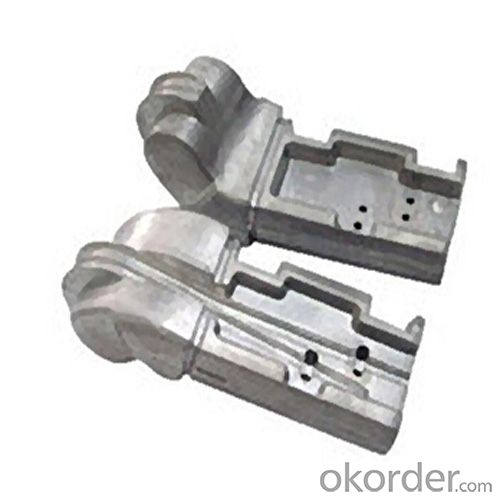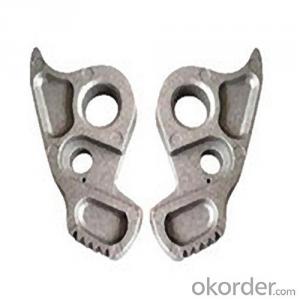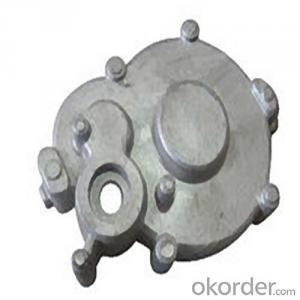Mold Metal Casting with High Quality and Best Price
- Loading Port:
- Guangzhou
- Payment Terms:
- TT OR LC
- Min Order Qty:
- 1000 pc
- Supply Capability:
- 100000 pc/month
OKorder Service Pledge
OKorder Financial Service
You Might Also Like
1. Structure of Mold Metal Casting Description:
The casting equipment and the metal dies represent large capital costs and this tends to limit the process to high volume production. Manufacture of parts using die casting is relatively simple, involving only four main steps, which keeps the incremental cost per item low. It is especially suited for a large quantity of small to medium-sized castings, which is why die casting produces more castings than any other casting process.[1] Die castings are characterized by a very good surface finish (by casting standards) and dimensional consistency.Two variants are pore-free die casting, which is used to eliminate gas porosity defects; and direct injection die casting, which is used with zinc castings to reduce scrap and increase yield.
2.Main Features of the Mold Metal Casting:
Die Casting
High Precison&Tolerance
Motor vehicle
External processing
3. Mold Metal Casting Images


4. Mold Metal Casting Specification
| Material | aluminum alloy A380,A360.ADC12,Zinc alloy 3#zinc,5#zinc and 7#zinc,etc |
| Designs | 1.As per the customer’s drawings 2.As per the customer’s samples |
| Surface treatment | 1.sand blasting, 2.power coating 3.painting 4.anodization 5.electrophoresis 6.zinc plating 7.black oxidation. |
| Software | Pro/E, Auto CAD, CAXA UG, CAD/CAM/CAE |
| Certificate | ISO9001:2008, ROHS,SGS |
| Service | OEM service available |
| Products | All kinds of aluminum &zinc alloy casting: include automotive parts, railroad parts, medical parts, marine parts, lighting parts, pump body, valve parts, architectural parts and furniture parts so on |
| Advantage | 1.With 8 years in Aluminum & zinc alloy casting; 2.Near shanghai Port and Air Port; 4.Passed ISO9001:2008/Rosh/SGS 5.From Casting to Finished surface, Owned casting, polishing and plating workshops, We can offer Good quality and strict delivery time. 6.With samples and order: We can offer dimension report,Chemical composition and Mechanical properties |
5.FAQ
Q. What is Die Casting? How is it different from other "casting" process?
"Die casting is the process of forcing molten metal under high pressure into mold cavities (which are machined into dies). Most die castings are made from non-ferrous metals." It's known as "pressure die casting" in Europe. "Gravity casting" (a.k.a. "permanent mold casting" in USA and Canada) uses gravity to fill the mold.
Q. I don't have experience designing parts for make mold metal casting , and want to bring existing machined parts to die casting. What should I know?
We have a professional person to help you.
- Q:How do aluminum profiles perform in terms of chemical resistance?
- The chemical resistance of aluminum profiles is typically good, but it can vary depending on the chemicals used. Aluminum is able to resist a wide range of acids, alkalis, and organic solvents. Furthermore, it has excellent resistance to atmospheric corrosion, making it suitable for outdoor use. Nevertheless, aluminum is not resistant to all chemicals. It can be vulnerable to corrosion when exposed to certain chemicals, especially those with high acidity or alkalinity. Aluminum profiles can corrode when in contact with strong acids like hydrochloric acid or sulfuric acid. Similarly, strong alkalis such as sodium hydroxide or potassium hydroxide can also corrode aluminum. In addition to the specific type of chemical, the concentration and temperature of the chemical can also impact the performance of aluminum profiles. Higher concentrations and elevated temperatures can increase the likelihood of corrosion. To enhance the chemical resistance of aluminum profiles, they can undergo various surface coatings or anodization. These treatments create a protective layer that improves resistance to corrosion caused by chemicals. In conclusion, although aluminum profiles generally possess good chemical resistance, it is crucial to consider the specific chemicals used, their concentration, and the temperature when determining their suitability for a particular application.
- Q:RT: you! What are coated aluminum profiles? What's the surface treatment? What's the difference between grain transfer and wood grain transfer? Thank you first!!!
- First, the noun explanation:Aluminum is coated on the surface of various lines in aluminum on the coated PVC film, decorative paint paper, wood skin, and instead of the traditional painting process, the formation of decorative materials, coating materials can be used for the production of door, wardrobe Rome top line, Rome line, column, wardrobe baseboard, gusset plate, curtain rod Aluminum Alloy, window, doors and windows, frames etc..Two. The origin of coated aluminum profile:Aluminum Alloy profiles the most common and most primitive (referred to as aluminum), is Aluminum Alloy itself color, silver white, but this state for a long time, Aluminum Alloy surface will be oxidized into a dark gray or black. In order to solve this problem, the most common practice in our country is to spray a layer of powder (high temperature treatment) on the surface, that is electrostatic powder spraying. Also, fluorocarbon electrophoresis processing processing, wood grain transfer, the transfer grain processing fidelity is not high, in order to solve this problem, there are a kind of film processing, high fidelity, but because the process requirements must be done in the film before powder spraying treatment, coupled with higher requirement on the film itself, so the cost is higher, more for a second tier city high-grade residential.
- Q:The latest list of aluminum China
- Lear aluminum is also good Oh, A Well-Known Trademark in China, China energy-saving innovation enterprise ten, Hebei enterprises in Handan
- Q:Are aluminum profiles suitable for balcony railings?
- Yes, aluminum profiles are suitable for balcony railings. Aluminum is a lightweight and durable material that is resistant to corrosion, making it an excellent choice for outdoor applications like balcony railings. Additionally, aluminum profiles can be easily customized and come in a variety of designs, making them versatile and aesthetically pleasing options for balcony railings.
- Q:Can aluminum profiles be anodized for improved corrosion resistance?
- Yes, aluminum profiles can be anodized for improved corrosion resistance. Anodizing is an electrochemical process that forms a protective layer of aluminum oxide on the surface of the metal. This layer not only enhances the appearance of the aluminum profile but also provides excellent corrosion resistance properties. During the anodizing process, the aluminum profile is immersed in an electrolytic solution and a direct current is applied. This causes oxidation to occur at the surface of the metal, resulting in the formation of a thick layer of aluminum oxide. This oxide layer is hard, durable, and tightly adheres to the underlying aluminum, providing a barrier against corrosion. The anodic oxide layer can further be enhanced by sealing it with various sealing methods, such as hot water sealing or chemical sealing. This helps to increase the resistance of the anodized aluminum profile against environmental factors like moisture, chemicals, and UV radiation. Anodized aluminum profiles have several advantages over non-anodized ones. They have improved resistance to corrosion, scratches, and wear. Additionally, anodizing can also provide the aluminum profile with a decorative finish, as it allows for a wide range of colors to be applied. Overall, anodizing is a highly effective method to enhance the corrosion resistance of aluminum profiles, making them suitable for various applications where protection against corrosion is essential, such as in construction, automotive, aerospace, and electronics industries.
- Q:Can aluminum profiles be used for electrical busbars?
- Yes, aluminum profiles can be used for electrical busbars. Aluminum offers excellent electrical conductivity, and its lightweight nature makes it a cost-effective choice for busbar applications. Additionally, aluminum profiles can be easily shaped and customized to meet specific requirements, making them suitable for various electrical systems.
- Q:What do you mean by aluminum alloy T3-T8? Someone who answers me, thanks a lot
- T3~T8 refers to the heat treatment process code after extrusionAs follows:T3 solid fusion heat treatment, cold processing, and then through the natural aging to the basic state of stabilityThe utility model is suitable for cold working, straightening or leveling to improve the strength after the solid fusion heat treatmentT4The natural aging is basically stable after the heat treatmentApply to solid melting heat treatment, no longer cold processing (can be short, straight and flat, but not affect mechanical performance limit) products
- Q:Can aluminum profiles be an alternative to wood in construction?
- Indeed, aluminum profiles have the potential to serve as a practical substitute for wood in the field of construction. Numerous advantages are associated with aluminum profiles, rendering them a favored choice in numerous construction projects. To begin with, aluminum profiles possess the dual qualities of being lightweight and robust, making them easily manageable and installable. This characteristic renders them suitable for a wide array of applications, including the creation of door and window frames, curtain walls, and partitions. Furthermore, aluminum profiles exhibit exceptional durability and resistance to weathering, corrosion, and pests, thereby ensuring a long-lasting and low-maintenance alternative. Moreover, aluminum profiles possess inherent fire-resistant properties, which can greatly enhance safety during the construction process. Unlike wood, aluminum does not burn, and boasts a high melting point, thereby reducing the likelihood of its contribution to the spread of fires. From an environmental standpoint, aluminum profiles offer a multitude of benefits. Aluminum is an eminently recyclable material, allowing for its repeated use and repurposing without compromising its inherent properties. This recyclability minimizes the environmental impact associated with construction projects and supports the concept of a circular economy. Furthermore, the design versatility of aluminum profiles is a distinct advantage. Aluminum can be easily shaped and extruded into various profiles and sizes, thereby enabling customization and flexibility in architectural designs. This adaptability renders aluminum profiles suitable for both functional and aesthetic purposes within the realm of construction. Nevertheless, it is vital to acknowledge that aluminum profiles may incur higher initial costs in comparison to wood. Additionally, aluminum possesses a higher thermal conductivity than wood, necessitating additional insulation to ensure optimal thermal performance. To conclude, due to their lightweight nature, durability, fire resistance, sustainability, and design versatility, aluminum profiles can serve as a viable alternative to wood in the field of construction. Though there may be certain considerations regarding cost and thermal conductivity, the numerous advantages of aluminum profiles make them an attractive option for a wide range of construction applications.
- Q:What industries commonly use aluminum profiles?
- Industries commonly using aluminum profiles include construction, automotive, aerospace, electronics, furniture, and renewable energy.
- Q:How do you calculate the strength of aluminum profiles?
- To calculate the strength of aluminum profiles, various factors need to be considered. First, the material properties of the aluminum, such as its yield strength and ultimate tensile strength, must be known. Then, the geometric characteristics of the profile, such as its cross-sectional area and moment of inertia, are used in relevant equations to determine the bending, shear, and axial strength of the profile. Additionally, factors like the loading conditions, support conditions, and safety factors are taken into account to ensure the calculated strength is reliable and safe.
1. Manufacturer Overview |
|
|---|---|
| Location | |
| Year Established | |
| Annual Output Value | |
| Main Markets | |
| Company Certifications | |
2. Manufacturer Certificates |
|
|---|---|
| a) Certification Name | |
| Range | |
| Reference | |
| Validity Period | |
3. Manufacturer Capability |
|
|---|---|
| a)Trade Capacity | |
| Nearest Port | |
| Export Percentage | |
| No.of Employees in Trade Department | |
| Language Spoken: | |
| b)Factory Information | |
| Factory Size: | |
| No. of Production Lines | |
| Contract Manufacturing | |
| Product Price Range | |
Send your message to us
Mold Metal Casting with High Quality and Best Price
- Loading Port:
- Guangzhou
- Payment Terms:
- TT OR LC
- Min Order Qty:
- 1000 pc
- Supply Capability:
- 100000 pc/month
OKorder Service Pledge
OKorder Financial Service
Similar products
New products
Hot products
Related keywords






























